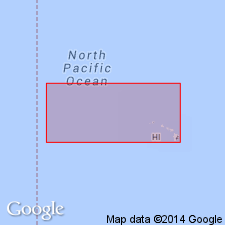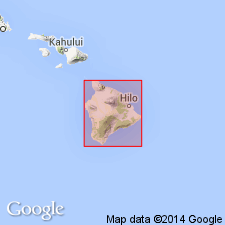
- Usage in publication:
-
- Waimea agglomerate
- Modifications:
-
- Named
- Dominant lithology:
-
- Pyroclastics
- AAPG geologic province:
-
- Hawaii
Summary:
Under heading 'The Waimea and Olaa Agglomerate" name "Waimea Formation" is proposed since "formation is apparently present along the entire coastal district from Honokina to the margin of the Waipo district and at the north it extends inland nearly or quite to Waimea... (Honomu, Mauna Kea, Hamakua and Waipo quadrangles)" [Island of Hawaii]. Near Honokina hummocky accumulations of agglomerate is as much as 20 ft thick. Underlies yellow tuff of Waiau formation. Older than Glenwood tuff and yellow tuff phase of Waiau formation.
Source: GNU records (USGS DDS-6; Menlo GNULEX).

- Usage in publication:
-
- Waimea agglomerate
- Modifications:
-
- Not used
- AAPG geologic province:
-
- Hawaii
Summary:
Rocks of Waimea Agglomerate now included in Laupahoehoe and Hamakua volcanic series. Assigned Pleistocene age [since part of volcanic rocks of Hamakua and Laupahoehoe volcanic series].
Source: GNU records (USGS DDS-6; Menlo GNULEX).
For more information, please contact Nancy Stamm, Geologic Names Committee Secretary.
Asterisk (*) indicates published by U.S. Geological Survey authors.
"No current usage" (†) implies that a name has been abandoned or has fallen into disuse. Former usage and, if known, replacement name given in parentheses ( ).
Slash (/) indicates name conflicts with nomenclatural guidelines (CSN, 1933; ACSN, 1961, 1970; NACSN, 1983, 2005, 2021). May be explained within brackets ([ ]).

